|
Related FAQs: Clownfishes, Clownfishes 2, Clownfishes 3,
Clownfish
Identification, Clownfish
Selection, Clownfish
Compatibility, Clownfish
Compatibility 2, Clownfish
Compatibility 3, Clownfish
Behavior, Clown
Behavior 2, Clown Behavior 3,
Clown Behavior 4, Clown Behavior 5, Clown Behavior 6, & Clownfish Systems, Clownfish Feeding, Maroon Clownfish, Maroon Clowns 2, Clownfish Diseases 1, Clownfish Diseases 2, Clownfish Diseases
3, Clownfish Disease 4,
Clownfish Disease 5, Clownfish Disease 6, Clownfish Disease 7, Clownfish Disease 8, Clownfish Disease 9, Clownfish Disease 10, Clownfish Disease 11, Clownfish Disease 12, Clownfish Disease 13, Clownfish Disease 14, Clownfish Disease 15,
Clownfish Disease 16,
Clownfish Disease 17,
Clownfish Disease 18,
Clownfish Disease 19,
Clownfish Disease 20,
Clownfish Disease 21,
Clownfish Disease 22,
Clownfish Disease 24,
Clownfish Disease 25,
Clownfish Disease 26,
Clownfish Disease 27, &
Brooklynellosis,
Breeding Clowns,
Clownfish
Reproduction 2,
Clownfish
Reproduction 3,
Clownfish
Reproduction 3, Clownfish Breeding 4,
Clownfish Breeding 5,
Clownfish Breeding 6, &
Clownfish and
Anemones, Clownfish/Anemones 2,
Clownfish/Anemones 3,
Clownfish/Anemones 4,
Clownfish/Hosts 5,
Anemones & Clowns 1,
Anemones & Clowns 2,
Damsel Selection,
Damsel Compatibility,
Damsel Feeding,
Damsel Disease,
Damsel Reproduction,
Related Articles: Maroon Clowns,
Brooklynellosis,
Damselfish,
Anemones,
Premnas Pix,
/The Conscientious
Marine Aquarist
The Clownfishes,
Damsels of the subfamily Amphiprionae, Part 2
To:
Part 1 ,
Part 3,
Part 4,
Part 5,
Part 6,
Part 7,
Part 8
|
|
|
By Bob Fenner
|
|
| Amphiprion chrysopterus Cuvier 1830, the
Orange-Fin Anemonefish. West to mid Pacific; Australia, New Guinea,
Marshall Islands, Tuamotus. Yellowish-orange accents on upper and
lower body and yellow tail. To six inches. Found in three species
of anemones in the wild. Some in captivity. A male and female below
in Fiji. |
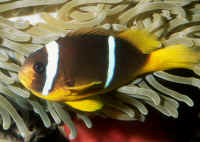 
|
| Amphiprion clarkii (Bennett 1830), Clarkii
or Yellowtail Clownfish. Indo-West Pacific; Persian Gulf to Western
Australia to Melanesia, Micronesia. To six inches in length. The
most variable species of the subfamily. Blackish to brown body
color, third white body bar on caudal peduncle, white or yellow
tail. At right in N. Sulawesi. Below: adult in the Maldives (typical dark color as with most
individuals found with Stichodactyla mertensii), and lastly
aquarium image. |
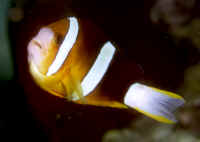
|
Bigger PIX:
The images in
this table are linked to large (desktop size) copies. Click on
"framed" images to go to the larger size. |
.JPG)
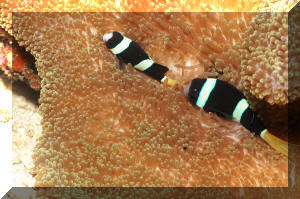
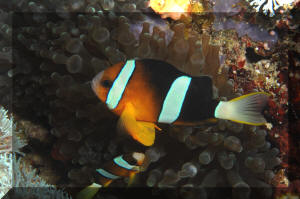
%20MD.JPG) |
| Amphiprion fuscocaudatus Allen 1972, the
Seychelles Anemonefish. Dark brown bodied with broad lower
golden-yellow areas including pectoral fins. Three wide body bands.
Seychelles, including Aldabra, western Indian Ocean. To five
inches. Found in the wild only in association with Stichodactyla
mertensii. |
No pic (and I've BEEN to the Seychelles!)
|
| Amphiprion latezonatus
Waite 1900, the Wide-Band Anemonefish. Dark brown bodied, with
three (especially the middle) wide white body bars. Found only off
Lord Howe Island and the coast near the Queensland-NSW border. This
one photographed at the Birch Aquarium, San Diego. To five inches
total length. |
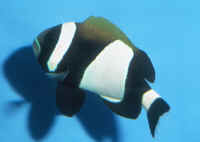
|
Bigger PIX:
The images in this table are
linked to large (desktop size) copies. Click on "framed"
images to go to the larger size. |
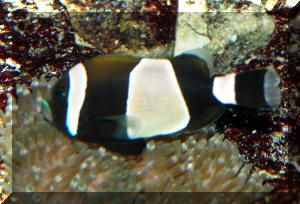
%20MD.jpg)
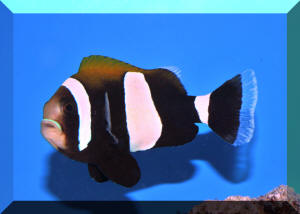
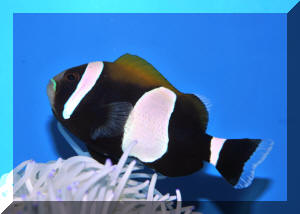 |
To:
Part 1,
Part 3,
Part 4,
Part 5,
Part 6,
Part 7,
Part 8
|
|

